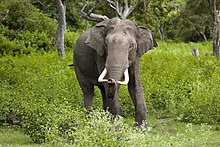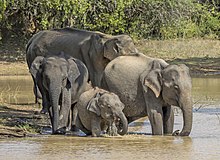| Asian elephant Temporal range:
| |
|---|---|

| |
| A tusked bull Bandipur National Park, Karnataka, India | |

| |
| A cow and juveniles Yala National Park, Sri Lanka | |
| Scientific classification | |
| Domain: | Eukaryota |
| Kingdom: | Animalia |
| Phylum: | Chordata |
| Class: | Mammalia |
| Order: | Proboscidea |
| Family: | Elephantidae |
| Genus: | Elephas |
| Species: | E. maximus[1]
|
| Binomial name | |
| Elephas maximus[1] | |
| Subspecies[1] | |

| |
historical range
range in early 21st century
| |
The Asian elephant (Elephas maximus), also known as the Asiatic elephant, is a species of elephant distributed throughout the Indian subcontinent and Southeast Asia, from India in the west to Borneo in the east, and Nepal in the north to Sumatra in the south. Three subspecies are recognised—E. m. maximus, E. m. indicus and E. m. sumatranus. The Asian elephant is characterised by its long trunk with a single finger-like processing; large tusks in males; laterally folded large ears but smaller in contrast to African elephants; and wrinkled grey skin. The skin is smoother than African elephants and may be depigmented on the trunk, ears or neck. Adult males average 4 tonnes (4.4 short tons) in weight, and females 2.7 t (3.0 short tons).
It is one of only three living species of elephants or elephantids anywhere in the world, the others being the African bush elephant and African forest elephant. Further, the Asian elephant is the only living species of the genus Elephas. It is the second largest species of elephant after the African bush elephant. It frequently inhabits grasslands, tropical evergreen forests, semi-evergreen forests, moist deciduous forests, dry deciduous forests and dry thorn forests. They are herbivorous, eating about 150 kg (330 lb) of vegetation per day. Cows and calves form groups, while males remain solitary or form "bachelor groups" with other males. During the breeding season, males will temporarily join female groups to mate. Asian elephants have a large and well-developed neocortex of the brain, are highly intelligent and self-aware being able to display behaviors associated grief, learning, greeting etc.
The Asian elephant is the largest living land animal in Asia. Since 1986, the Asian elephant has been listed as Endangered on the IUCN Red List, as the population has declined by at least 50 per cent over the last three elephant generations, which is about 60–75 years. It is primarily threatened by loss of habitat, habitat degradation, fragmentation and poaching. Wild Asian elephants live to be about 60 years old. While female captive elephants are recorded to have lived beyond 60 years when kept in semi-natural surroundings, Asian elephants die at a much younger age in captivity; captive populations are declining due to a low birth and high death rate. The earliest indications of captive use of Asian elephants are engravings on seals of the Indus Valley civilisation dated to the 3rd millennium BC.
- ^ a b Shoshani, J. (2005). "Species Elephas maximus". In Wilson, D.E.; Reeder, D.M (eds.). Mammal Species of the World: A Taxonomic and Geographic Reference (3rd ed.). Johns Hopkins University Press. p. 90. ISBN 978-0-8018-8221-0. OCLC 62265494.
- ^ Williams, C.; Tiwari, S.K.; Goswami, V.R.; de Silva, S.; Kumar, A.; Baskaran, N.; Yoganand, K. & Menon, V. (2020). "Elephas maximus". IUCN Red List of Threatened Species. 2020: e.T7140A45818198. doi:10.2305/IUCN.UK.2020-3.RLTS.T7140A45818198.en. Retrieved 15 January 2022.
- ^ "Appendices". Convention on International Trade in Endangered Species of Wild Fauna and Flora (CITES). Archived from the original on 5 December 2017. Retrieved 6 June 2022.
